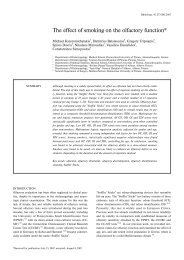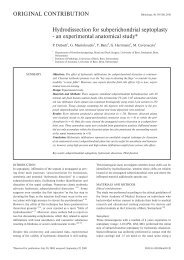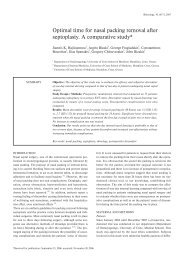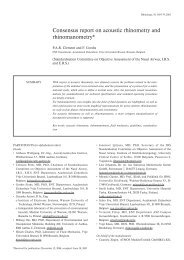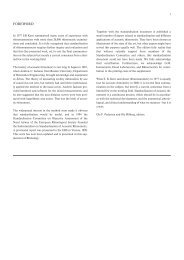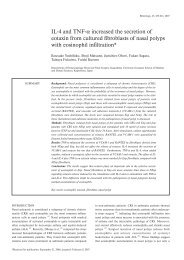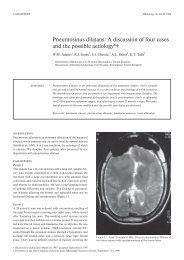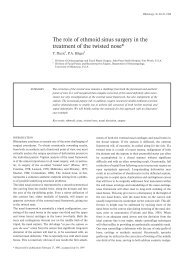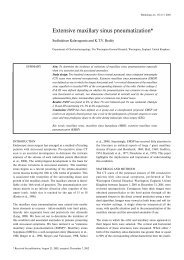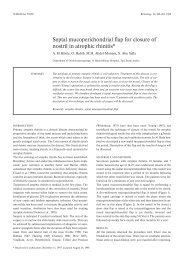Short-time variation in nasal mucosal swelling: a ... - ResearchGate
Short-time variation in nasal mucosal swelling: a ... - ResearchGate
Short-time variation in nasal mucosal swelling: a ... - ResearchGate
Create successful ePaper yourself
Turn your PDF publications into a flip-book with our unique Google optimized e-Paper software.
Rh<strong>in</strong>ology, 41, 7-10, 2003<br />
<strong>Short</strong>-<strong>time</strong> <strong>variation</strong> <strong>in</strong> <strong>nasal</strong> <strong>mucosal</strong> swell<strong>in</strong>g:<br />
a rh<strong>in</strong>ostereometry study*<br />
Eva Ellegård<br />
Department of Otorh<strong>in</strong>olaryngology, Kungsbacka Hospital, Kungsbacka, Sweden<br />
SUMMARY<br />
Rh<strong>in</strong>ostereometry is an optical method to detect changes <strong>in</strong> <strong>nasal</strong> <strong>mucosal</strong> swell<strong>in</strong>g. The<br />
method needs further specifications for standardised use. This study was performed <strong>in</strong> order<br />
to def<strong>in</strong>e the <strong>in</strong>ter-<strong>in</strong>dividual <strong>variation</strong>, and to f<strong>in</strong>d whether the <strong>in</strong>tra-<strong>in</strong>dividual short-<strong>time</strong><br />
<strong>variation</strong> is greater, say, at the beg<strong>in</strong>n<strong>in</strong>g of a sequence of registrations, as has been claimed.<br />
Bilateral registrations were made every 2 m<strong>in</strong>utes for 30 m<strong>in</strong>utes <strong>in</strong> healthy, non-smok<strong>in</strong>g<br />
subjects, 15 women, and 15 men. The figures of each <strong>nasal</strong> cavity were evaluated separately.<br />
Compared with basel<strong>in</strong>e, the range of changes was -2.9 to 3.0 mm, mean value 0.12 mm,<br />
with a standard deviation of 0.39 mm. No stabilisation of the <strong>variation</strong> was seen over <strong>time</strong>.<br />
There was no correlation with age or sex. The left and right nostrils changed degree of<br />
swell<strong>in</strong>g <strong>in</strong>dependently <strong>in</strong> most cases, but <strong>in</strong> 8 cases there was a significant correlation<br />
between the nostrils. The <strong>time</strong> required for each pair of bilateral registrations varied between<br />
15 and 90 s (mean 34 s, standard deviation 10 s). Data from the present study can be used<br />
for statistical power calculations <strong>in</strong> the plann<strong>in</strong>g of rh<strong>in</strong>ostereometry studies us<strong>in</strong>g parallel<br />
groups.<br />
Key words: <strong>nasal</strong> mucosa, congestion, rh<strong>in</strong>ostereometry, normal <strong>variation</strong>, statistics<br />
INTRODUCTION<br />
Standardisation and guidel<strong>in</strong>es for new methods are necessary<br />
for compar<strong>in</strong>g the results from different studies. Specifications<br />
are needed <strong>in</strong> order to obta<strong>in</strong> values of accuracy and repeatability<br />
for the equipment used. An ambitious document on<br />
acoustic rh<strong>in</strong>ometry concern<strong>in</strong>g such data was recently presented<br />
(Hilberg and Pedersen, 2000).<br />
Rh<strong>in</strong>ostereometry is an optical method used to measure differences<br />
<strong>in</strong> <strong>nasal</strong> <strong>mucosal</strong> swell<strong>in</strong>g. The method has been used <strong>in</strong><br />
several studies on rh<strong>in</strong>itis medicamentosa (Graf et al., 1995;<br />
Graf and Juto, 1995; Graf, 1996), and on benzalkonium chloride<br />
(Hallén and Graf, 1995; Graf and Hallén, 1996).<br />
Measurements of reactions to histam<strong>in</strong>e provocations are frequently<br />
used, and a 0.4-mm congestion 5 m<strong>in</strong>utes after histam<strong>in</strong>e<br />
2 mg/ml has been proposed to differentiate hyperreactive<br />
subjects from controls (Hallén and Juto, 1993).<br />
In all published studies, the basel<strong>in</strong>e position is said to be<br />
determ<strong>in</strong>ed by repeated record<strong>in</strong>gs of the <strong>in</strong>ferior turb<strong>in</strong>ates.<br />
When I used the method for the first <strong>time</strong> (Ellegård and<br />
Karlsson, 1999), I frequently found it hard to obta<strong>in</strong> a stable<br />
basel<strong>in</strong>e.<br />
The aim of the present study was to def<strong>in</strong>e the <strong>variation</strong> <strong>in</strong> rh<strong>in</strong>ostereometry<br />
registrations <strong>in</strong> men and women, and whether<br />
the <strong>variation</strong> is <strong>in</strong>fluenced, say, by how early the registrations<br />
come <strong>in</strong> a sequence or not, that is, if and when a stabilisation<br />
occurs.<br />
MATERIAL AND METHOD<br />
Fifteen women aged 25-58 (mean 43.6 years) and 15 men aged<br />
16-58 (mean 41.3 years) were studied. They were non-smok<strong>in</strong>g,<br />
with neither <strong>nasal</strong> problems nor medications. Respiratory tract<br />
<strong>in</strong>fection must not have occurred with<strong>in</strong> 2 weeks before the<br />
study. Three of the women and 4 of the men had a history of<br />
hayfever, but were studied months out of season.<br />
In rh<strong>in</strong>ostereometry, <strong>in</strong>vented and first described by Juto &<br />
Lundberg (1982), the subject bites on a tooth spl<strong>in</strong>t connected<br />
to the frame of the converted eye microscope. This is done <strong>in</strong><br />
order to ma<strong>in</strong>ta<strong>in</strong> a stable and repeatable exposure of the nose.<br />
The microscope can be moved <strong>in</strong> three dimensions, and its<br />
angle towards the nose can be altered, giv<strong>in</strong>g 4 coord<strong>in</strong>ates<br />
used to def<strong>in</strong>e the registration position for observ<strong>in</strong>g the <strong>nasal</strong><br />
mucosa. As the depth of field is very narrow, the focused area<br />
observed at the registration position moves along the mmscale<br />
<strong>in</strong> the ocular as the thickness of the mucosa changes. A<br />
Rh<strong>in</strong>ostereometer type S (Rh<strong>in</strong>omed, Lid<strong>in</strong>gö, Sweden) was<br />
used as recommended by the manufacturer. The coord<strong>in</strong>ates<br />
were established with an accuracy of 0.1 mm. Aural exam<strong>in</strong>a-<br />
* Received for publication: April 26, 2002; accepted August 13, 2002
8 Ellegård<br />
tion funnels of appropriate sizes were used to observe the<br />
anterior borders of the <strong>in</strong>ferior turb<strong>in</strong>ates.<br />
After 30 m<strong>in</strong>utes of acclimatisation to the <strong>in</strong>door climate, registration<br />
positions were selected by choos<strong>in</strong>g focused areas on<br />
the anterior edges of both <strong>in</strong>ferior turb<strong>in</strong>ates. Further bilateral<br />
registrations were made every 2 m<strong>in</strong>utes for 30 m<strong>in</strong>utes, start<strong>in</strong>g<br />
with the right side every <strong>time</strong>. The tooth spl<strong>in</strong>t was kept <strong>in</strong><br />
the mouth between right and left registrations. Registrations<br />
were also made 15 m<strong>in</strong>utes after adm<strong>in</strong>ister<strong>in</strong>g a <strong>nasal</strong> spray of<br />
100 µg oxymetazol<strong>in</strong>e hydrochloride (Nezeril ® 0.5 mg/ml,<br />
Draco, Lund, Sweden).<br />
The <strong>time</strong> consumed for every pair of registrations was registered.<br />
Care was taken that no disturb<strong>in</strong>g moments would occur<br />
dur<strong>in</strong>g the study <strong>time</strong>; there was a sign on the door to prevent<br />
disturbance, no stress, and only trivial conversation was<br />
allowed.<br />
All participants gave their <strong>in</strong>formed consent. The study was<br />
approved by the Ethics Committee of Sahlgrenska University<br />
Hospital, Göteborg.<br />
Figure 1. Variation over <strong>time</strong>. The standard deviation (=SD) of the difference<br />
between the mean value of each set of registrations and the<br />
previous one did not stabilise over <strong>time</strong> <strong>in</strong> 30 healthy subjects.<br />
Statistical tests<br />
Differences from basel<strong>in</strong>e were used for analyses.<br />
Autocorrelation was used on every <strong>in</strong>dividual value and the<br />
one preced<strong>in</strong>g, <strong>in</strong> order to evaluate the <strong>time</strong> dependence <strong>in</strong><br />
every <strong>nasal</strong> cavity. The standard deviation (=SD) of the difference<br />
between the mean value of all sets of registrations and<br />
the previous one were established <strong>in</strong> order to register <strong>time</strong><br />
dependence. The correlation between mean change over <strong>time</strong><br />
<strong>in</strong> right and left <strong>nasal</strong> cavities was established by Pearson correlation.<br />
The relation between age and <strong>variation</strong> <strong>in</strong> <strong>mucosal</strong><br />
swell<strong>in</strong>g was established by l<strong>in</strong>ear regression of the logarithms<br />
of the SDs on age. In the comparison between female and<br />
male, the quotient of the mean SD was calculated.<br />
RESULTS<br />
No one experienced any subjective <strong>nasal</strong> obstruction dur<strong>in</strong>g<br />
the study <strong>time</strong>.<br />
The range of differences compared with the basel<strong>in</strong>e, observed<br />
dur<strong>in</strong>g 30 m<strong>in</strong>utes, was from -2.9 mm to 3.0 mm. The mean<br />
swell<strong>in</strong>g was 0.12 mm, with a total <strong>variation</strong> over <strong>time</strong> and<br />
<strong>in</strong>dividuals (SD) of 0.39 mm over 30 m<strong>in</strong>utes. The correspond<strong>in</strong>g<br />
values of the first registration, after 2 m<strong>in</strong>utes, were a mean<br />
value of 0.06 mm, and a SD of 0.39 mm.<br />
In 12 isolated <strong>nasal</strong> cavities, the autocorrelation between successive<br />
<strong>in</strong>dividual registrations <strong>in</strong>dicated a significant dependence,<br />
given by values greater than 0.5 or smaller than -0.5<br />
(possible values -1 to 1, range -0.16 to 0.75). The <strong>variation</strong> was<br />
not stabilised over <strong>time</strong> (see Figure 1).<br />
In 8 subjects, there was a significant correlation between read<strong>in</strong>gs<br />
from the right and left <strong>nasal</strong> cavities (see example <strong>in</strong><br />
Figure 2), given by values greater than 0.5 or smaller than -0.5<br />
(possible values -1 to 1, range -0.51 to 0.76). However, <strong>in</strong> some<br />
cases the <strong>nasal</strong> cavities seemed to react as two separate organs<br />
(see example <strong>in</strong> Figure 3). Most noses showed small changes<br />
Figure 2. Registrations from a subject whose nostrils changed <strong>in</strong> parallel.<br />
Figure 3. Registrations from a subject whose nostrils reacted as two<br />
separate organs.<br />
over <strong>time</strong> (see example <strong>in</strong> Figure 4), but <strong>in</strong> some cases the<br />
changes were more pronounced (see example <strong>in</strong> Figure 5).<br />
There was no significant relation between age and <strong>variation</strong> <strong>in</strong>
<strong>Short</strong>-<strong>time</strong> rh<strong>in</strong>ostereometry 9<br />
can be used for calculations <strong>in</strong> the plann<strong>in</strong>g of studies (mean<br />
change 0.06 mm, SD 0.39 mm).<br />
Figure 4. Registrations from a subject who showed small changes <strong>in</strong><br />
swell<strong>in</strong>g over <strong>time</strong>.<br />
Figure 5. Registrations from a subject who showed pronounced<br />
changes <strong>in</strong> swell<strong>in</strong>g over <strong>time</strong>.<br />
<strong>mucosal</strong> swell<strong>in</strong>g (R=0.01, P=0.94). Also, there was no difference<br />
found <strong>in</strong> <strong>variation</strong> due to sex. The mean SD of women /<br />
men = 0.44 / 0.35 = 1.3 (95% confidence <strong>in</strong>terval 0.75, 2.21).<br />
The mean value after decongestion was -2.0 mm (SD= 1.0<br />
mm) compared with the basel<strong>in</strong>e. The <strong>time</strong> required for a<br />
bilateral registration varied between 15 and 90 seconds (mean=<br />
34 s, SD= 10 s).<br />
DISCUSSION<br />
In this study of the normal <strong>variation</strong> <strong>in</strong> bilateral rh<strong>in</strong>ostereometry<br />
<strong>in</strong> healthy subjects over 30 m<strong>in</strong>utes, I found a mean<br />
swell<strong>in</strong>g compared with basel<strong>in</strong>e of 0.12 mm, rang<strong>in</strong>g from -2.9<br />
to 3 mm, with a total mean SD of 0.39 mm. The <strong>variation</strong> did<br />
not improve conv<strong>in</strong>c<strong>in</strong>gly over <strong>time</strong>: no stabilisation was found<br />
(see Figure 1). In only 12 isolated <strong>nasal</strong> cavities was there a<br />
correlation between successive <strong>in</strong>dividual registrations.<br />
Therefore, the values from the first registration, at 2 m<strong>in</strong>utes,<br />
In statistical power calculation, accord<strong>in</strong>g to Law (1993), with<br />
parallel groups, for an estimated power of 90%, and a significance<br />
level of 0.05, the required number of subjects <strong>in</strong> each<br />
group is 2 x ((10.5 x (SD) 2 ) / D 2 ) + 2, where D is the difference<br />
we seek. With our SD of 0.39, and with a difference of 0.4 mm,<br />
we will need 22 subjects <strong>in</strong> each group = 2 x ((10.5 x 0.39 2 ) /<br />
0.42 2 ) + 2. For crossover studies, the <strong>in</strong>tra-<strong>in</strong>dividual SD over<br />
days (not established <strong>in</strong> the present study) should be used <strong>in</strong><br />
the correspond<strong>in</strong>g equation: ((10.5 x (SD) 2 ) / D 2 ) + 2.<br />
Juto & Lundberg (1984) studied the <strong>variation</strong> <strong>in</strong> <strong>nasal</strong> mucosa<br />
congestion dur<strong>in</strong>g rest <strong>in</strong> 7 male and 7 female volunteers by<br />
bilateral registrations every 20 m<strong>in</strong>utes for 4 hours.<br />
Unfortunately, not all results are presented, but <strong>in</strong> 3 cases<br />
there seem to have been changes of 2-3 mm, which is <strong>in</strong> the<br />
same magnitude as the results of the present study.<br />
In a 14-m<strong>in</strong>ute study on 9 volunteers, Grudemo & Juto (1999)<br />
found changes of up to 2.1 mm <strong>in</strong> registrations made every 2<br />
m<strong>in</strong>utes. As rh<strong>in</strong>ostereometry was comb<strong>in</strong>ed with laser<br />
Doppler flowmetry, and registrations were made with<strong>in</strong> 30 seconds,<br />
I presume they were unilateral. No data is presented as<br />
to whether the changes were <strong>in</strong>fluenced by <strong>time</strong> or not. The<br />
authors state that “it is obvious that <strong>in</strong> most subjects there are<br />
pronounced short term <strong>variation</strong>s <strong>in</strong> congestion, especially dur<strong>in</strong>g<br />
the acclimatisation period”. The present study did not give<br />
any evidence of stabilisation <strong>in</strong> 30 m<strong>in</strong>utes.<br />
The total <strong>in</strong>herent error of the method is reported to be 0.27<br />
mm when the edge of the focused area on the <strong>mucosal</strong> surface<br />
moves 0 mm, and 0.37 mm when it moves 4 mm (Juto and<br />
Lundberg, 1982). The <strong>variation</strong> found <strong>in</strong> the present study<br />
<strong>in</strong>cludes these figures and a physiological short-<strong>time</strong> <strong>variation</strong><br />
<strong>in</strong> <strong>nasal</strong> <strong>mucosal</strong> swell<strong>in</strong>g. Thus there is an <strong>in</strong>stability <strong>in</strong> the<br />
vasomotor tone, even though care was taken that no disturb<strong>in</strong>g<br />
moments would occur dur<strong>in</strong>g the study <strong>time</strong>, as discussed earlier<br />
(Rh<strong>in</strong>ology, <strong>in</strong> press)[reference is now known].<br />
As shown <strong>in</strong> this study, it takes more than a few seconds to<br />
perform a bilateral registration. The <strong>time</strong> I required for bilateral<br />
registrations varied greatly. In no case, however, did I<br />
exceed the maximum <strong>time</strong> of 2 m<strong>in</strong>utes set by Juto <strong>in</strong> his 4-<br />
hour study (Juto and Lundberg, 1984).<br />
Rh<strong>in</strong>ostereometry is an important tool. It can be used to measure<br />
small changes <strong>in</strong> <strong>nasal</strong> <strong>mucosal</strong> swell<strong>in</strong>g with great accuracy.<br />
In statistical power calculations for study plann<strong>in</strong>g the <strong>variation</strong><br />
reported <strong>in</strong> this study should be taken <strong>in</strong>to consideration.<br />
Repeated registrations on the same occasion are not needed, as<br />
the <strong>variation</strong> was not shown to change over 30 m<strong>in</strong>utes.<br />
ACKNOWLEDGEMENTS<br />
This study was f<strong>in</strong>ancially supported by the Göteborg Medical<br />
Society, Göteborg, Sweden. Special thanks to Professor Alvar<br />
Ellegård for revis<strong>in</strong>g my English, and to Professor Göran<br />
Karlsson for constructive discussions.
10 Ellegård<br />
REFERENCES<br />
1. Ellegård E, Karlsson G (1999) IgE-mediated reactions and hyperreactivity<br />
<strong>in</strong> pregnancy rh<strong>in</strong>itis. Arch Otolaryngol Head Neck Surg<br />
125: 1121-1125.<br />
2. Ellegård E (2002) Practical aspects on rh<strong>in</strong>ostereometry. Rh<strong>in</strong>ology<br />
40: 115-117.<br />
3. Graf P (1996) Long-term use of oxy- and xylometazol<strong>in</strong>e <strong>nasal</strong><br />
sprays <strong>in</strong>duces rebound swell<strong>in</strong>g, tolerance and <strong>nasal</strong> hyperreactivity.<br />
Rh<strong>in</strong>ology 34: 9-13.<br />
4. Graf P, Hallén H (1996) Effect on the <strong>nasal</strong> mucosa of long-term<br />
treatment with oxymetazol<strong>in</strong>e, benzalkonium chloride and placebo<br />
<strong>nasal</strong> sprays. Laryngoscope 106: 605-609.<br />
5. Graf P, Hallén H, Juto J-E (1995) The pathophysiology and treatment<br />
of rh<strong>in</strong>itis medicamentosa. Cl<strong>in</strong> Otolaryngol 20: 224-229.<br />
6. Graf P, Juto J-E (1995) Susta<strong>in</strong>ed use of xylometazol<strong>in</strong>e <strong>nasal</strong><br />
spray shortens the decongestive response and <strong>in</strong>duces rebound<br />
swell<strong>in</strong>g. Rh<strong>in</strong>ology 33: 14-17.<br />
7. Grudemo H, Juto J-E (1999) Studies of spontaneous fluctuations<br />
<strong>in</strong> congestion and <strong>nasal</strong> <strong>mucosal</strong> microcirculation and the effects<br />
of oxymetazol<strong>in</strong>e us<strong>in</strong>g rh<strong>in</strong>ostereometry and micromanipulator<br />
guided laser Doppler flowmetry. Am J Rh<strong>in</strong>ol 13 (1): 1-6.<br />
8. Hallén H, Graf P (1995) Benzalkonium chloride <strong>in</strong> <strong>nasal</strong> decongestive<br />
sprays has a long-last<strong>in</strong>g adverse effect on the <strong>nasal</strong> mucosa of<br />
healthy volunteers. Cl<strong>in</strong> Exp Allergy 25: 401-405.<br />
9. Hallén H, Juto J-E (1993) A test for objective diagnosis of <strong>nasal</strong><br />
hyperreactivity. Rh<strong>in</strong>ology 31: 23-25.<br />
10. Hilberg O, Pedersen OF (2000) Acoustic rh<strong>in</strong>ometry: recommendations<br />
for technical specifications and standard operationg procedures.<br />
Rh<strong>in</strong>ology 38 (suppl. 16): 3-17.<br />
11. Juto J-E, Lundberg C (1982) An optical method for determ<strong>in</strong><strong>in</strong>g<br />
changes <strong>in</strong> <strong>mucosal</strong> congestion <strong>in</strong> the nose <strong>in</strong> man. Acta<br />
Otolaryngol (Stockh) 94: 149-156.<br />
12. Juto J-E, Lundberg C (1984) Variation <strong>in</strong> <strong>nasal</strong> mucosa congestion<br />
dur<strong>in</strong>g rest. Acta Otolaryngol (Stockh) 98: 136-139.<br />
13. Law MR (1993) Small trials rather than large observational studies<br />
<strong>in</strong> nutritional epidemiology. Eur J Cl<strong>in</strong> Nutr 47 (4): 229-231.<br />
Eva Ellegård MD, PhD.<br />
Department of Otorh<strong>in</strong>olaryngology<br />
Kungsbacka Hospital<br />
S-434 80 Kungsbacka<br />
Sweden<br />
Tel: + 46-300-565284<br />
Fax: + 46-300-565301<br />
E-mail: eva.ellegard@lthalland.se<br />
ANNOUNCEMENT<br />
Department of Otorh<strong>in</strong>olaryngology<br />
<strong>in</strong> cooperation with the Departments of Anatomy,<br />
Dermatology, Plastic Surgery and Maxillo-Facial Surgery<br />
University Medical Centre St Radboud Nijmegen,The Netherlands<br />
Under auspices of the European Rh<strong>in</strong>ologic Society and<br />
the European Academy of Facial Plastic Surgery (Joseph Society)<br />
May 14 /15 /16<br />
2003<br />
4 th International Course<br />
on Reconstructive and Aesthetic Surgery<br />
of the Nose and Face<br />
External rh<strong>in</strong>oplasty<br />
Transposition flaps and vascularized flaps<br />
Nasal reconstruction<br />
Otoplasty<br />
Blepharoplasty<br />
Mentoplasty<br />
Rhytidoplasty<br />
Techniques mentioned above are expla<strong>in</strong>ed<br />
step by step by a multidiscipl<strong>in</strong>ary <strong>in</strong>ternational<br />
faculty of experts.After each presentation a<br />
technique is practised hands on. Instead of<br />
employ<strong>in</strong>g chemicals to preserve cadavers, they<br />
are freezed and brought to room temperature,<br />
provid<strong>in</strong>g the feel and texture of facial soft tissue.<br />
Information<br />
K. Ingels<br />
Organisation by PAOG-Heyendael:<br />
P.O. Box 9101<br />
6500 HB Nijmegen<br />
The Netherlands<br />
tel: +31 24 3610342<br />
fax: +31 24 3540568<br />
e-mail: a.wolf@paog.umcn.nl



